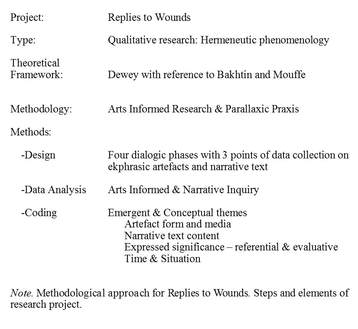|
Research Project Introduction
Phase 1: Clothesline canvases
Phase 2: Artist-Researcher interpretive works Phase 3: Participant open studio Culminating Exhition Replies to Wounds is a study of the Clothesline Project at Washington State University (WSU), a collection which has grown to 400– 500 shirts over approximately 15 years. The Clothesline Project was first implemented by the WSU Women’s Resource Center in 1993 and continues today.The original Clothesline Project began with a small group of women activists from Hyannis, Massachusetts in 1990 who had a desire to “consciously develop a program that would educate, break the silence and bear witness to one issue - violence against women” (National Network, 2007). While the narrative content and the goal of the Clothesline Project continues to evolve over time, generally, the shirts act as narrative canvasses for participants to express their experience of interpersonal violence.
The Clothesline Project is a bricolage of expression - figuratively and actually – as demonstrated in the forms of narrative texts and in its collective public assemblage. In turn, I engaged the research process as a Bricoleur or a maker of assembled and juxtaposed images and expressive narratives into data-based and artful montages that are evolving, “pragmatic, strategic, and self-reflexive” (Denzin & Lincoln, 2000, p. 4). Both the Clothesline project and this research project are constructions – parallaxic perspectives- where researcher, participants, and audience members can dwell and reflect. The purpose of this study is to describe research on the Washington State University (WSU) Clothesline Project CP event (1993–2012) and ekphrasic artefacts about the experience of Interpersonal violence (IPV), utilizing arts-informed research (AIR) (Cole & Knowles, 2008) methodology within a Deweyan (1934/2005) theoretical framework and reference to Bakhtinian (Holquist & Liapunov, 1990; Morris, 1994) and Mouffian ideas (2007, 2008, 2013). The primary research question for this study is: Utilizing a Deweyan theoretical framework and the artefacts of the CP, what are the emergent themes and expressed meanings across three transactive and ekphrasic interpretations about the experience of interpersonal violence, with implications for educational strategies? The artful interpretations or ekphrasic works created within this study are derived from textual and design analysis of the Clothesline Project artefacts. It is through the creation of artful representations combined with the textual and design analysis that new knowledge, meaning, and understanding will be rendered. These interrelated analytic processes allow me to look at recurring themes emerging from the data, specific linguistic choices and potential meaning suggested therein, and finally possible themes or messages conveyed through the texts themselves. |






